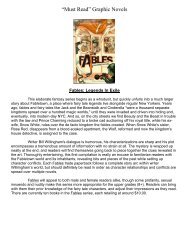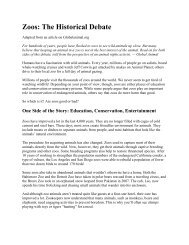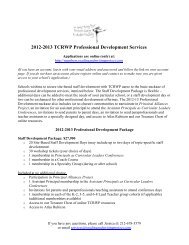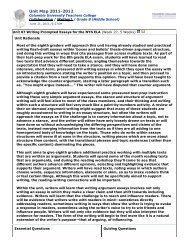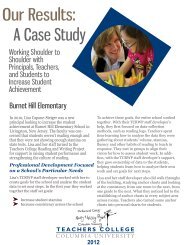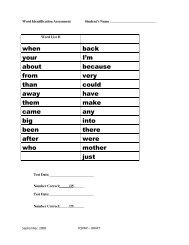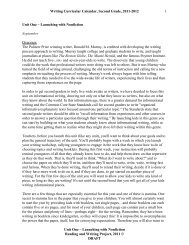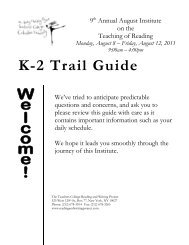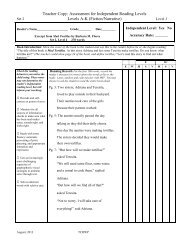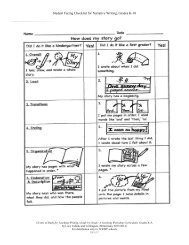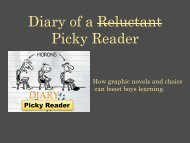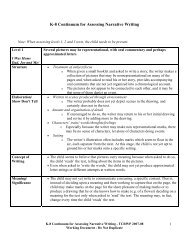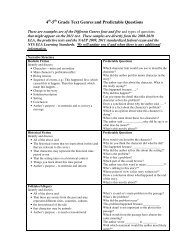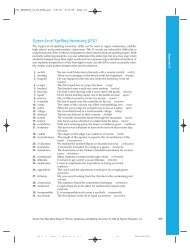6 -8 Grade Text Genres and Predictable Questions - The Reading ...
6 -8 Grade Text Genres and Predictable Questions - The Reading ...
6 -8 Grade Text Genres and Predictable Questions - The Reading ...
You also want an ePaper? Increase the reach of your titles
YUMPU automatically turns print PDFs into web optimized ePapers that Google loves.
6 th -8 th <strong>Grade</strong> <strong>Text</strong> <strong>Genres</strong> <strong>and</strong> <strong>Predictable</strong> <strong>Questions</strong><strong>The</strong>se are examples are of the Different <strong>Genres</strong> <strong>and</strong> types of questions that mightappear on the 2011 test. <strong>The</strong>se samples are directly from the 2008-2010 ELA, thepredictive tests <strong>and</strong> the NAEP 2009, 2011 st<strong>and</strong>ardized federal exam <strong>and</strong> the NYS ELALearning St<strong>and</strong>ards. We will update you if <strong>and</strong> when there is any additionalinformation.* Indicates what students had trouble withNarrative StructureRealistic FictionIdentify <strong>and</strong> discuss:• Characters – main <strong>and</strong> secondary• Main character’s problem/conflict• Rising tension• Sequence of events, e.g.: This happened first, whichcaused this to happen. <strong>The</strong>n this happened, whichmade this happen…• Change in the story• Solution/resolution• Setting• Conclusion• Author’s purpose – to entertain <strong>and</strong> to convey amessageHistorical FictionIdentify <strong>and</strong> discuss:• All of the above <strong>and</strong>:• <strong>The</strong> historical events that we learn about in this (<strong>and</strong>that are relevant to this story)• That characters may represent the historical timeperiod or not• That the setting takes on a historical context• Things you learn about this time period• Author’s purpose – to entertain <strong>and</strong> informFolktales/AllegoryIdentify <strong>and</strong> discuss:• All of the above <strong>and</strong>:<strong>Predictable</strong> <strong>Questions</strong>What character trait would you use to describe thecharacter?What is the same about these two characters?Why did the author put this minor character in thestory?Which is a fact about the character’s problem?Which is an opinion about what this character isdoing?Can you name the detail that talks about how thecharacter solves problem?This happened because…..*Why did this happen?*Draw a conclusion about why the author said …. *<strong>The</strong> author says this about the character. What ishe/she really saying?*<strong>The</strong> author said _____________Why did he say itor what does he mean?*What is this mostly about?*<strong>Predictable</strong> <strong>Questions</strong>How would you describe this character?Why do you think the character did what he/shedid?Why did the author tell us this about the setting?*What is the problem?Why is that a problem?This happened because __________________Which part of this could be true?<strong>The</strong> author uses this word to mean ___________*Who’s talking in this story?*Whose point of view is this story written in?*Whose perspective is being represented here?*Draw a conclusion about what happened at the endof the story.What is this mostly about?*What is the author telling us about this timeperiod?*What’s so <strong>and</strong> so’s main problem in the passage?
• That these are stories from the past <strong>and</strong> mayrepresent different cities, countries, cultures• the lesson/moral of the tale• that characters may be animals• Author’s purpose – to teach a lesson/moralNarrative Non Fiction (Students had difficulty withthe informational side to this)Identify <strong>and</strong> discuss:• All of the above (narrative, not folktales/allegory)• That this is a story but it is about a real person orsubject or situation• Person’s struggles, motivations, <strong>and</strong> achievements• Information about the world/time period/subject thatis taught through this true narrative• Author’ purpose – to informDrama ( This is br<strong>and</strong> new)Identify <strong>and</strong> discuss:• All of the above (narrative, not folktales/allegory)<strong>and</strong>:• <strong>The</strong> author’s use of scenes• <strong>The</strong> narrator’s role• Particular lines <strong>and</strong> their significance• That plays have characters, setting, dialogue,narrators, stage direction, <strong>and</strong> propsWhat’s the problem?Why did the problem occur?This problem happened because___________Which words from the passage have almost thesame meaning?Which detail is not important to the plot in thispassage?<strong>The</strong> author wrote _________ to_______With which statement would the author most likelyagree?*Which sentence best tells the theme of thepassage?*What moral does this passage teach you?*Which trait would you use to describe the person inthe text?Why did the author put this minor person in thestory?*This happened because…..Why did this happen?Which is a fact about the person’s problem?Can you name the detail that talks about how theperson solves the problem?What happened right after ____________?What is the same about these two people?<strong>The</strong> author said _____________why did he say it orwhat does he mean?*<strong>The</strong> author says this about the person. What ishe/she really saying?*What motivated the person to do what he or shedid?This person achieved _______*This story gives us information about__________What is this mostly about?*<strong>The</strong> author write this because he/she wanted us toknow ______________?*Draw a conclusion about why the author said …. atthe end*How do __________dialogue <strong>and</strong> stage directionsgive an actor ideas about playing the character?After this scene the audience is supposed to predictthat ____________Lines that describe the scene <strong>and</strong> setting couldbe___________Which of these is an example of words spoken bynarrator 2?Which is an example of a prop that was used?<strong>The</strong> stage direction that suggests that________should speak the dialogue that followsis_________<strong>The</strong> play can best be described as a _______Which choice best describes the play from which
Classics (This is a new one)Identify <strong>and</strong> discuss:• All of the above (narrative, not folktales/allegory)<strong>and</strong>:• How this genre draws attention to human problems• How this genre looks at point of view• <strong>The</strong> use of effective language, including figurativelanguage• How the author makes you believe that what is saidshould hold meaningBiographyIdentify <strong>and</strong> discuss:• All of the above (Narrative Nonfiction) <strong>and</strong>:• Why the person became great• That the perspective is that of another person ratherthan the subject of the biography (as is the case withan autobiography)• <strong>Text</strong> boxes <strong>and</strong> picture support to locate information• Discussion in conclusion of accomplishments• Author’s purpose – to informAutobiography (Students had problems with this)• All of the above (Biography <strong>and</strong> NarrativeNonfiction) <strong>and</strong>:• About <strong>and</strong> written by the same person• Author’s purpose – to informthe scene was taken?Who is the major character in the story?What is the conflict the characters are goingthrough?How does the setting influence the character?How does the character resolve the problem?Why did the author say ___________?How does the author use this form of symbolism todescribe the character’s internal conflict?What is the theme of the story?Which trait would you use to describe the person inthe text?Which is a fact about the person’s problem?Can you name the detail that talks about how theperson solves her problem?Who is writing the story?*Who is talking?Which is an opinion about what this person did?Why did the author put this minor person in thestory?This happened because…..Why did this happen?Draw a conclusion about why the author said …. *What motivated the person to do what he or shedid?This person achieved _______This story gives us information about__________*What happened right after ____________?<strong>The</strong> author said _____________Why did he say itor what does he mean?*Draw a conclusion about how what ________ didwill be used __________*Who wrote the story?Why did this person write this story?*What is this mostly about?*Which trait would you use to describe the subject ofthe text?Who is writing the text?Who is talking?<strong>The</strong> author says this about the person. What is shereally saying?What is the same about these two characters?Why did the author put this minor character in thestory?What motivated the person to do what she did?Which is a fact about the person’s problem?Which is an opinion about what this character isdoing?Can you name the detail that talks about how theperson solves the problem?
Expository StructureInformational (Students had a problem with this)Identify <strong>and</strong> discuss:• How to, All About, Question <strong>and</strong> Answer,Advertisements, List , Letter, Reports• That this type of text provides information pertainingto a main idea <strong>and</strong> details to support that main idea• Titles, questions <strong>and</strong> captions support the main idea• <strong>Text</strong> boxes <strong>and</strong> picture support to locate information• New information, misleading pictures, captions, textmessagesHybridMixed genreBoth StructuresPoetry (Students often had problems with this)Identify <strong>and</strong> discuss:• That a poem may tell a story• That a poem may provide information• That a poem may draw a picture• Figurative language• Stanzas• White Space• Repeating language• <strong>The</strong>me(s)<strong>The</strong> author said _____________Why did she say itor what does she mean?This happened because…..Why did this happen?What happened right after ____________?This person achieved _______This autobiography gives us informationabout__________Draw a conclusion about why the author said …. atthe end.What is this mostly about?Draw a conclusion about how what ________ didwill be used __________What happened after ____________?What happened before _____________?Who is this report written for?Why did this report start?Who is writing the letter <strong>and</strong> why?What’s the purpose of the letter?What structure is this letter written in?Who is interviewing you?What do the questions that are being asked tell usabout the main purpose of the interview?Why is the author giving us this information?Which is a fact?This word means __________Which detail supports what we are saying about?Why did __________ change after ____________?What is the purpose of the illustration __________?Which detail tells us __________?What are two reasons _________used to supporther argument?What is ___________ trying to_______?<strong>The</strong> author wrote this report to __________What is this mostly about?What is another title for this story?What is the main idea?Which detail best supports the main idea?Refer to the sample genreWhy does the character do something or not?How does ___________ feel at the beginning of thepoem?What would _______ do next?How does __________ feel at the end of the story?Which stanza could not really happen?Read these lines from the poem: ______________.What do these lines most likely mean?
• Rhyme (when applicable)• Alliteration, <strong>and</strong> the use of literary devices such asidioms, personification, similes <strong>and</strong> metaphorsWhich line best describes how __________expresses _____________?Read these lines from the poem:_________ Howwould _________most likely respond to theselines?What point of view do _________ <strong>and</strong> _________share?<strong>The</strong>re is alliteration in lines ___________ <strong>and</strong>___________Which of these words from the poem imitate a____________?<strong>The</strong> author is telling you ___________ about thesubjects of the poem?<strong>The</strong> character in the middle of the poem decided to____________?Which element of poetry is not found in thesestanzas?What feeling is the speaker expressing in the poem?<strong>The</strong> statement ___________________(figurativelanguage) means _______________What is the rhyme scheme on the first stanza of thispoem?<strong>The</strong> tone of the poem is ____________According to the _____________ the_____________ symbolizes __________?<strong>The</strong> narrator sees the main character in the poem as_________How does the poet feel about _________?Who is talking in the poem?



